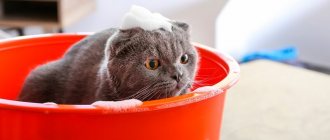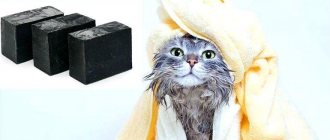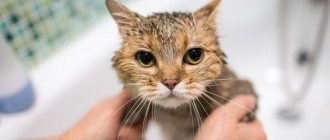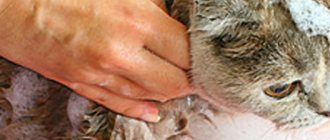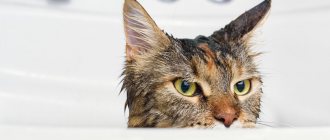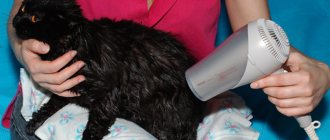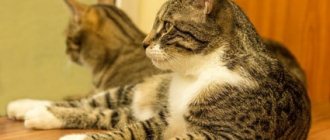Is special shampoo for cats a ploy by advertisers or is it still an objectively important cosmetic for a pet? Veterinarians say that every loving owner should purchase cat shampoo. But what to do if you don’t have such a remedy at home, but you need to tidy up the mess as quickly as possible? How to wash a cat in the absence of specialized cosmetics?
Mr. Cat explains: is it possible to wash a cat with human shampoo?
In order to wash the cat painlessly for everyone, this should be approached responsibly, training the pet in a timely manner and preparing all the necessary means. Sometimes you don’t have “cat” shampoo on hand, and then the question arises: is it possible to wash a cat with human shampoo?
Veterinarians and breeders are categorically against the use of “human” shampoos for pet care.
They give the following arguments:
- The hair structure of cats and humans is too different. Cats have fewer glands that secrete sweat and oil. Therefore, human shampoo contains a much higher content of surfactants, which in such quantities simply dry out the skin and fur of pets.
- The epidermis (i.e. the upper part of the skin) of a pet is much thinner and more sensitive than that of a person.
- The value of the acidity index also differs. A cat's pH is 4-6, a person's is from 3 to 4.5.
- Cats have two types of hair: guard hair and down hair. There is an air cushion between them, so a cat’s coat is a whole system that needs very delicate influence (we write more about the structure of hair in cats at the end of the article, so read to the end, there is a lot of useful information there).
- The presence in human shampoos of aromatic and often strong-smelling substances, microscopic additives for shine or tint, harmful to cats.
- Many “human” detergent compositions contain extracts from herbs and other natural components that can cause allergic reactions in cats.
Of course, if you wash your cat with “human” shampoo once, and with all the precautions, then the harm will be minimal. The main thing is not to do this systematically; it is still better to purchase a specialized cleaning composition for your pet. After all, manufacturers develop pet shampoos taking into account the characteristics of the coat, and products for humans, when used regularly, can cause irreparable harm to the appearance and health of a cat. The wool will fade, lose its natural shine, become dull and brittle, and will mat and form tangles.
Why do you need to bathe your pets?
Hygiene procedures for such pets are always associated with stress. At the same time, not only the animal itself, but also its owner. Therefore, in order to bathe a kitten there must be a good reason for this. Among the main factors influencing the need to wash a cat are :
- preparing purebred pets for exhibitions or similar events;
- destruction of fleas or other parasites on the animal’s fur;
- the presence of a huge amount of dirt (especially light-colored pets);
- during the period when the animal sheds and hair falls out in large quantities;
In such cases, there is a special need to wash the kitten so that your pet is a clean and fluffy bundle.
Regular shampoos
What to do if there is no suitable shampoo
If there is an urgent need to bathe your pet and you don’t have a cat wash product at hand, then preference should be given to the following “human” shampoos:
- For children without fragrances (for example, with the smells of apples or peaches) - they contain the least harmful substances and contain components that allow bathing “without tears.” Some breeders even specifically wash kittens with it if they have allergies.
- Contains birch tar. They are relevant for lichen or skin irritations in your pet.
- Based on goat's milk or kumis without additional fragrances, it moisturizes the hair and skin of cats well.
In any case, in these exceptional cases, you must choose a product without a strong odor, with a low composition of surfactants, and exclude the content of menthol or pepper.
When using such detergent compositions, it is better to dilute them strongly beforehand (up to one tablespoon per liter of liquid), and after soaping the animal, rinse the foam thoroughly (at least three to four times) until the water becomes clear. Then the pet is dried with a towel to reduce the licking time.
Useful video
- When you bathe a cat, do it with someone else - this will make it easier to hold the animal.
- Do not raise your voice to the animal and be extremely gentle.
- After shampooing, rinse the animal's fur thoroughly because it licks itself.
- If bathing is done to drive away fleas, then start with the neck - soap this part of the body, and only then the entire animal.
- The head and ears are washed last, and it is better not to wash them at all. Clean your ears with cotton swabs.
- Remember - the cat should not be overcooled.
Visually see how you can bathe a kitten with regular shampoo.
Today you found out how many times you can wash a kitten with shampoo and whether you can wash a kitten with baby shampoo and regular shampoo.
Shampoos for cats
If bathing your pet is necessary, you should choose the appropriate shampoo. They come in three types:
- Regular liquid products. They vary in coat type and are sold in any pet store.
- Dry shampoo powders. Created specifically for animals that are too afraid of water or have thick, long, long-drying hair.
- Sprays also offer the opportunity to provide an alternative to water bathing. A special composition is applied to the pet’s fur and rubbed with a dry cloth. This is a fairly expensive method of cleaning a pet and is not yet very widespread, although it is effective.
Today, regular liquid cat shampoos are still popular. They, in turn, are divided into the following groups.
Read about how to properly wash a cat.
Caring shampoos for cats
These products also contain a weak concentration of alkali and are designed to improve the appearance of the coat and hair structure, giving it shine and silkiness, preventing excessive loss and brittleness. Most often, they also contain various vitamin supplements and fatty acids.
There are also specialized vitamin shampoos that are used with oral intake of complexes enriched with micro- and macroelements.
There are special shampoos for excessive oily hair that regulate the functioning of the sebaceous glands. This is ensured by the inclusion of herbal extracts, for example, from tea tree, and antibacterial complexes.
Preventive shampoos for dry hair, on the contrary, moisturize and nourish hairs due to substances similar to sebaceous secretions. The hairs seem to be sealed and become unaffected by ultraviolet radiation.
Modern industry also produces a wide range of detergents for cats of various breeds: Bengals, Britons, Maine Coons, Sphynxes. All of these shampoos have different effects on the coat and skin of pets. For example, “Graceful Sphinx,” in addition to cleansing and nourishing the skin of hairless cats, prevents the occurrence of acne, to which this type of pet is so susceptible. This occurs due to the inclusion of chamomile and other medicinal components.
For Persian cats, a composition is produced that nourishes the follicles and makes it easier to comb long and thick downy hair, preventing the formation of tangles.
Cosmetics for cats
These are not only shampoos, but also balms, tonics, and tint compositions. Most often they are used in the care of show animals to give cats a special shine before competitions.
The progressive part of humanity, however, condemns the use of tinted shampoos, as this is extremely dangerous for the health of pets.
Why wash your cat
Cats lick themselves very often, completely several times a day, and in between they will definitely run their tongue over their paws, tail or sides. However, in some situations, bathing your pet is inevitable:
- Before a competition, show or exhibition. In this case, the animal owner, as a rule, has all the necessary specialized hair care products.
- In case of heavy pollution, for example, after a long walk in the rain.
- If substances come into contact with the fur that may be hazardous to the health of the pet.
- With heavy shedding. This is especially true for representatives of long-haired and some semi-long-haired breeds. These pets often suffer during such periods from excessive ingestion of hairballs.
- For medicinal purposes, in particular, when removing external parasites.
However, it must be remembered that excessive bathing can lead to disruption of the protective lubricant and, as a result, to loss of shine and health of the coat. Three to four times a year is the optimal number of procedures.
If the cat often walks, especially at the dacha in the summer, then you can simply wipe it periodically with a damp cloth, and wash only the paw pads every day.
Similar to the need for bathing, there are situations when this procedure is unacceptable:
- If the animal has recently undergone surgery. Washing should be delayed as long as possible, even after sutures and bandages are removed.
- The advanced age of the pet also imposes a ban on bathing. For an old cat, this is too much stress and the risk of getting sick from hypothermia.
- You should also not bathe a pregnant or lactating cat. She doesn’t need foreign odors, additional stress or hypothermia.
- You should postpone the procedure even in the cold season, especially if the house is not too warm or there are drafts.
How often can you wash your cat and at what temperature?
Has anyone ever wondered why cats are afraid of water? How justified is their fear? For animals, everything is much simpler; they are not subject to groundless panic. The fear of water in cats is due to the following:
- After swimming, they are at risk of hypothermia or overheating. The air cushion formed between the skin and fur of the cat warms it. After bathing, it disappears, the animal freezes. Also, the coat, naturally moistened with sebum, protects the cat from the scorching rays of the sun. A washed pet loses this protection.
- There is a risk of infection. The cat's sebaceous glands produce a secretion with antibacterial properties. During bathing, it is washed away, leaving the animal defenseless against bacteria, fungi, and other infections.
- Wet wool smells. Cats are by nature nocturnal animals and hunters. They have strong camouflage instincts. Purrs carefully bury feces behind them and carefully lick their fur coat so as not to emit odors. Washed cat fur smells very strongly, and this makes the cat very worried.
Bathing is stressful for a cat.
Therefore, you need to know how often to wash your cat. Veterinarians recommend:
- regularly once every 2-3 months, if the animal is healthy
- more often as needed and after consultation with a specialist
According to the standards established by the World Society of Animal Health:
- Domestic cats need to be bathed three to four times a year.
- If your pet is used to walking outside, then the frequency of bathing should be increased to 6-7 times a year. It is also necessary to clean the furry paws when he comes home from the street.
You shouldn’t get carried away and wash your cat often, especially if there are no detergents designed for this purpose, and you are looking for options on how to wash your cat if there is no special shampoo. Frequently repeated water procedures, and especially with alternative means, leads to a disruption of the pH level (skin fat balance) of the animal, and then the natural protection on the cat’s skin disappears.
How to properly bathe a kitten
In order to gently bathe a small kitten, you should use a specialized shampoo, using baby product only as a last resort.
When bathing your baby, you need to be especially careful not to overcool the kitten, not to pour water into his ears and rub him thoroughly after washing, not to scare him or cause stress.
In the case of using specialized medicated shampoos, they are used strictly as prescribed by the veterinarian and in this case the pet is bathed according to the proposed scheme. As a rule, in this case we are talking about antiallergic drugs, since compositions for removing external parasites up to six months of life are not prescribed due to the high toxic effect of the drugs they contain on the body.
If the kitten is a show class and is planned to be presented at exhibitions and competitions in the future, then it is better to accustom the baby to bathing from an early age. Of course, you shouldn’t do this in the first or even the second month of life, but in three or four months the first procedure can be carried out.
If the kitten has recently moved to a new home, then washing should be delayed for at least two to three weeks to give it time to adapt.
It is also important to postpone bathing for at least a month after vaccinations.
It is important to carefully comb your pet before washing, since if the tangled hairs get wet, tangles are highly likely to form, which can only be removed by cutting.
If your baby begins to get stressed while combing his hair, then you should not immediately take him to the bathroom; it is advisable to give him time to calm down and tune in to a positive mood.
In addition, you can give him treats and play. Under no circumstances should you bathe a kitten immediately after a heavy feeding. You must wait at least two to three hours.
Warm water is filled into a container—a bathtub or basin—preferably at the animal’s body temperature, about 38 °C. To prevent the paws from sliding on the surface of the container, it is advisable to place a towel on the bottom. You can throw toys into the water, this will distract the kitten’s attention during the procedure. By the way, the whole thing should be done in 15 minutes. In this case, it is advisable to prepare the water for rinsing in a separate container in advance. You should douse your baby from a jug or ladle, and not frighten him with the noise of the shower.
The fur should be carefully lathered with the fingers of one hand, carefully holding the pet with the other.
To protect the ears, you can put cotton pads in them, but it is better to wash the face very carefully and last, trying to prevent water from getting into them - this is fraught with otitis media.
It is generally better not to touch the ears. If there are any problems, it is better to contact a veterinarian for cleaning, for example, wax plug. Especially if there is a suspicion of ear mites, this disease is called otodectosis and manifests itself in the formation of characteristic black dots inside the ear.
If after bathing and rubbing the kitten is clearly cold, then it is better to wrap it in a dry towel and carry it in your arms than to use a hairdryer. Firstly, the noise really frightens the baby, and secondly, hot air dries out the hair and makes it brittle.
It is advisable that the first procedure take place positively, in a playful atmosphere. After bathing and completely drying, you need to play with the baby and treat him with a treat and praise him.
Bathing a kitten for the first time
Those owners who are going through this procedure for the first time are worried and worried about how to wash the kitten for the first time. The most important condition for a successful bath is that you need to carefully prepare for such an important event in the baby’s life so that the procedure goes quickly and is not too tiring for the animal.
Before washing you need to prepare everything that will be needed in the process; it will be much easier if everything is at hand. It is better to carry out the procedure itself in a bathtub, sink or in a bowl, which is filled with 6-10 cm of water (depending on the size of the baby). The water should be warm, not hotter than 38 °C.
Note! The bathing procedure should be carried out when the baby is not hungry, is absolutely healthy, has already had enough fun and is in a good mood. It is better to bathe your furry pet a couple of hours after eating, when he has had enough of playing and is in a relaxed state.
It is better to bathe your furry pet a couple of hours after eating, when he has had enough of playing and is in a relaxed state.
It’s great if someone assists the baby during the bathing procedure: this way one person can distract his attention, and the second can quickly do all the necessary manipulations. The room where the kitten will bathe should be warm and under no circumstances should there be drafts
The room where the kitten will bathe should be warm and under no circumstances should there be drafts.
The sequence of actions when bathing a kitten is approximately as follows:
If the owner is afraid that water may get into the kitten’s ears during bathing, then it is better to cover them with tampons soaked in vegetable oil.
This is not necessary if you are confident in the accuracy of the actions. The kitten, carefully held by the withers, is placed in a container of water, where he either stands or sits - it all depends on how he feels more comfortable. It is important that he does not slip during the bathing procedure, so it would be good to lay a towel on the bottom or a rug, it will be much more comfortable for the baby. Carefully wet the animal's fur from the neck to the tail and, holding it, apply shampoo, but very carefully so as not to get into the eyes, ears and mouth. Using gentle movements, carefully rub the shampoo into the fur, this way not only it, but also the animal’s skin will be washed. The applied shampoo is washed off carefully but thoroughly. The baby’s head should not be wet; at the end of the bath, you can gently wipe the baby’s face and eyes with a damp hand. After completing the procedure, the animal is wrapped in a towel that can absorb water well. Its head should be left outside. After carrying out water procedures, do not forget about the need to carry out other important measures: the baby must clean his ears, trim his claws if necessary, and wipe his eyes.
While bathing, you need to talk to your pet gently and calmly, so as not to scare him with a loud and sharp cry. After the event is over, you can pamper your baby with his favorite treat.
Drying a kitten
The kitten wrapped in a towel is held in your arms and periodically blotted with a towel for 10-15 minutes. After this time, the kitten’s fur will have dried out enough, and it can be released onto a litter or sofa.
At the end of bathing, you need to clean the cat’s ears, wipe his eyes and trim his claws.
You should not actively dry the animal’s fur with a towel, as it can be damaged.
How to wash if the cat is afraid
A cat's fur protects it well from overheating and excessive cooling, and when wet, the air cushion between the hairs and skin fills with water, and the animal begins to freeze very much. This is why most pets do not like bathing and strive to avoid this procedure with all their might.
Read the article why cats are afraid of water and what to do about it.
In addition, the aroma of detergents is also unpleasant for cats; their delicate sense of smell is simply shocked by these odors. However, specialized cat shampoos take this criterion into account and do not contain fragrances.
If a cat is not accustomed to bathing from an early age, and is also afraid of water, then this procedure can become serious stress for both the pet and the owner.
In order to irritate your cat as little as possible, you should adhere to the following rules:
- It is advisable to invite someone from your household to help.
- Pre-comb the cat's fur and trim its claws.
- Under no circumstances should you shout at your pet; you should only speak in a gentle and soothing tone.
- It is better to place an anti-slip mat at the bottom of the bathing container.
- Remove from the surrounding area everything that could interfere, fall, or additionally frighten the cat, for example, bottles of shampoos and conditioners standing on the edge of the bathtub.
- Prepare several large dry towels.
- Prepare water for rinsing in a separate container; it is better to do it using a jug rather than a shower, so that the extra noise does not further frighten the cat.
- Fill a basin or bathtub with water at the animal’s body temperature so that its surface is slightly higher than the level of the cat’s belly.
- It is worth starting the procedure when the pet is relaxed and calm.
- Going into the bathroom with him, hold him in your arms for a while, talking affectionately.
- Then carefully place in water.
- While your assistant is holding the cat, quickly lather the fur with cat shampoo.
- Then thoroughly but quickly rinse your pet from the ladle at least three times.
- Place the cat on the bathroom floor and rub him well with a towel.
- Then wrap it in a second dry cloth and leave the bathroom.
- Carry the cat in your arms, calming and talking to him affectionately.
- Do not use a hairdryer under any circumstances, this will only frighten your pet even more and discourage him from bathing forever.
- Once the animal is dry enough, lower it to the floor and let it lick itself.
- Play, talk affectionately, offer the cat a treat, praise.
How to rid a cat of fleas
Anti-flea collars and drops on the withers may be effective, but they will not lead to complete eradication (destruction) of parasites. They will reduce the number of fleas, providing temporary relief. You cannot do without bathing with shampoo containing insecticides.
Drops on the withers are used if it is impossible to use tablets or a suspension, and are applied so that the cat cannot peel off the substance.
As you know, water procedures for a cat are significant stress. But there are bathing rules that will make the procedure for the cat and its owner as painless as possible (in every sense of the word).
Detergents containing insecticides—anti-flea agents—become mandatory. A shampoo with antiparasitic ingredients should ideally contain extracts of beneficial herbs that reduce inflammation and itching. This makes it easier to combat flea dermatitis.
How often to wash your cat and use flea shampoo
Prepare and place in the bathroom all the necessary bathing accessories in advance.
- Prepare a plastic bowl the size of the cat.
- The water in the basin should be warm. Because If cats have a body temperature of 38 to 40˚C, then this level of heating should be maintained.
- Lower the basin to the bottom of the bath. Put the cat there. Make sure that the animal rests its front paws on the side of the pelvis. The main thing in this procedure is to keep the cat's back to you! If she turns to face the person doing the washing, there is a risk for him to be scratched and bitten.
- Hold the cat's shirtfront with your hand. Water it with small portions of water taken from the basin with your hand (like a small child).
- Scoop shampoo into your palm. It is better to do this with one hand and hold the cat with the other. Next, lightly foaming, apply shampoo to the cat's fur with massaging movements. There shouldn't be a lot of foam. It is better to use a universal product for cats and kittens, which is suitable for any length of hair. On average, you need to keep the shampoo on the skin and coat for 1-2 minutes. After taking a bath, long-haired cats need additional brushing!
Make sure that the foam does not get into the cat's eyes and mouth.
It is very important to thoroughly rinse the shampoo from the cat’s fur and wrap the pet in a towel after bathing.
How often to wash your cat until it is completely healed
The life cycle of fleas (transformation of a larva into an adult) is 14 days. Therefore, to completely destroy blood-sucking insects, every two weeks you should treat the animal’s skin and fur with anti-flea shampoo.
Special anti-flea shampoos are the most popular and safe for cats.
The lifespan of fleas is 2-3 months.
Therefore, disinsection must be carried out every 2 weeks during this period. Total: you will have to use anti-flea shampoo 4 to 6 times, depending on the degree and area of skin damage by parasites.
